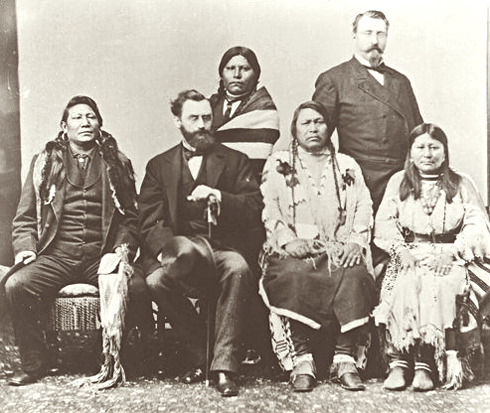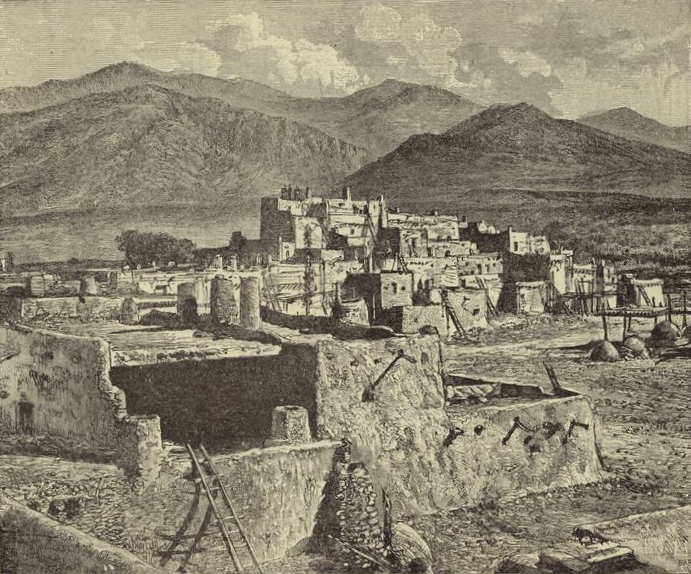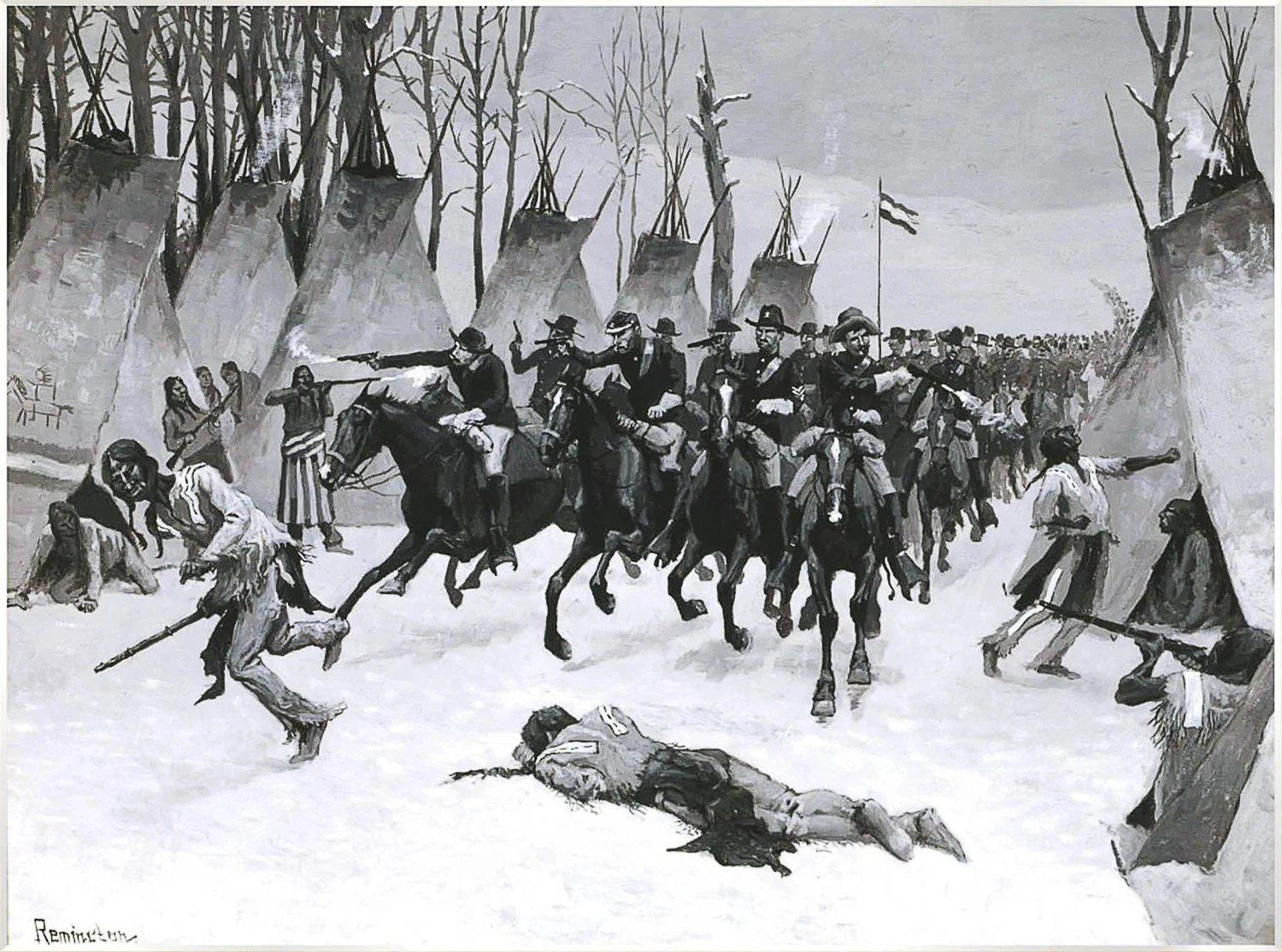|
Nicaagat
Nicaagat (leaves becoming green, c. 1840–1882), also known as Chief, Captain and Ute Jack and Green Leaf. A Ute warrior and subchief, he led a Ute war party against the United States Army when it crossed Milk Creek onto the Ute reservation, which triggered the Battle of Milk Creek. Prior to the conflict, he had traveled to meet up with Major Thomas Tipton Thornburgh to learn of his intentions and warn him that crossing the Milk Creek onto the White River Ute reservation would be seen as an invasion and an act of war. When the army entered the reservation, a shooter from Nicaagat's band shot and killed Thornburgh. He went to Washington, D.C. to speak before Congress following the battle to defend his actions. As a boy, Nicaagat was orphaned and then sold to a Mormon family. He was educated at a school with white children and attended church with the family. He lived with the family a number of years and ran away after being threatened to be whipped. He traveled to Colorado and j ... [...More Info...] [...Related Items...] OR: [Wikipedia] [Google] [Baidu] |
Battle Of Milk Creek
Meeker Massacre, or Meeker Incident, White River War, Ute War, or the Ute Campaign), took place on September 29, 1879 in Colorado. Members of a band of Ute people, Ute Indians (Native Americans of the United States, Native Americans) attacked the Indian agency on their reservation, killing the Indian agent Nathan Meeker and his 10 male employees and taking five women and children as hostages. Meeker had been attempting to convert the Utes to Christianity, to make them farmers, and to prevent them from following their nomadic culture. On the same day as the massacre, United States Army forces were en route to the Agency from Fort Steele (Wyoming), Fort Steele in Wyoming due to threats against Meeker. The Utes attacked U.S. troops led by Major (rank), Major Thomas T. Thornburgh at Milk Creek, north of present day Meeker, Colorado. They killed the major and 13 troops. Relief troops were called in and the Utes dispersed. The conflict resulted in the Utes losing most of the lands ... [...More Info...] [...Related Items...] OR: [Wikipedia] [Google] [Baidu] |
Thomas Tipton Thornburgh
Thomas Tipton Thornburgh (December 26, 1843 – September 29, 1879) was a career soldier, starting during the American Civil War when he enlisted with the Sixth East Tennessee Volunteers for the Union Army. Mid-war, he left the ranks to study at the United States Military Academy at West Point, graduating in 1867. After serving in the west for a number of years, he was made the commander of Fort Steele and Indian scout who received orders to establish peace with the White River Utes. With about 180 men, Thornburgh entered the White River Ute Reservation on September 16, 1879, and he and 13 of his men where killed during the Battle of Milk Creek. Early life Thomas Tipton Thornburgh was born in New Market, Tennessee on December 26, 1843, the son of Olivia and M. Thornburgh, an attorney. Both of his parents were born in Tennessee. He had an older brother, Jacob, who was Congressman Thornburgh of Tennessee, and an older sister, Mary. Military career In 1861, Thornburgh enlisted in th ... [...More Info...] [...Related Items...] OR: [Wikipedia] [Google] [Baidu] |
Ouray (Ute Leader)
Ouray (, c. 1833 – August 20, 1880) was a Native American chief of the Tabeguache (Uncompahgre) band of the Ute tribe, then located in western Colorado. Because of his leadership ability, Ouray was acknowledged by the United States government as a chief of the Ute and he traveled to Washington, D.C. to negotiate for the welfare of the Utes. Raised in the culturally diverse town of Taos, Ouray learned to speak many languages that helped him in the negotiations, which were complicated by the manipulation of his grief over his five-year-old son, abducted during an attack by the Sioux. Ouray met with Presidents Lincoln, Grant, and Hayes and was called the "man of peace" because he sought to make treaties with settlers and the government. Following the Meeker Massacre (White River War) of 1879, he traveled in 1880 to Washington, D.C. He tried to secure a treaty for the Uncompahgre Ute, who wanted to stay in Colorado; but, the following year, the United States forced the Uncompahgr ... [...More Info...] [...Related Items...] OR: [Wikipedia] [Google] [Baidu] |
National Museum Of Natural History
The National Museum of Natural History (NMNH) is a natural history museum administered by the Smithsonian Institution, located on the National Mall in Washington, D.C., United States. It has free admission and is open 364 days a year. With 4.4 million visitors in 2023, it was the List of most-visited museums in the United States, third most-visited museum in the United States. Opened in 1910, the museum on the National Mall was one of the first Smithsonian buildings constructed exclusively to hold the national collections and research facilities. The main building has an overall area of with of exhibition and public space and houses over 1,000 employees. The museum's collections contain over 146 million specimens of plants, animals, fossils, minerals, rock (geology), rocks, meteorites, human remains, and human cultural artifacts, the largest natural history collection in the world. It is also home to about 185 professional natural history scientists—the largest grou ... [...More Info...] [...Related Items...] OR: [Wikipedia] [Google] [Baidu] |
Aspen, Colorado
Aspen is the List of municipalities in Colorado#Home rule municipality, home rule city that is the county seat and the List of municipalities in Colorado, most populous municipality of Pitkin County, Colorado, United States. The city population was 7,004 at the 2020 United States census. Aspen is in a remote area of the Rocky Mountains' Sawatch Range and Elk Mountains (Colorado), Elk Mountains, along the Roaring Fork River at an elevation just below on the Western Slope of Colorado, Western Slope, west of the Continental Divide. Aspen is now a part of the Glenwood Springs, CO Micropolitan Statistical Area. Founded as a mining camp during the Colorado Silver Boom and later named Aspen for the abundance of aspen trees in the area, the city boomtown, boomed during the 1880s, its first decade. The boom ended when the Panic of 1893 led to a collapse of the silver market. For the next half-century, known as "the quiet years", the population steadily declined, reaching a nadir of few ... [...More Info...] [...Related Items...] OR: [Wikipedia] [Google] [Baidu] |
Sand Creek Massacre
The Sand Creek massacre (also known as the Chivington massacre, the battle of Sand Creek or the massacre of Cheyenne Indians) was a massacre of Cheyenne and Arapaho people by the U.S. Army in the American Indian Genocide that occurred on November 29, 1864, when a 675-man force of the Third Colorado Cavalry under the command of U.S. Volunteers Colonel John Chivington attacked and destroyed a village of Cheyenne and Arapaho people in southeastern Colorado Territory, killing and mutilating an estimated 70 to over 600 Native American people. Chivington claimed 500 to 600 warriors were killed. However, most sources estimate around 150 people were killed, about two-thirds of whom were women and children.Reilly, H.J. (2011). Bound to have blood: Frontier newspapers and the Plains Indian genocide. Lincoln, NE: University of Nebraska Press p. 21Rajtar, Steve, ''Indian War Sites: A Guidebook to Battlefields, Monuments, and Memorials'', McFarland & Company, Inc., Jefferson, North Ca ... [...More Info...] [...Related Items...] OR: [Wikipedia] [Google] [Baidu] |
Craig, Colorado
Craig is a home rule municipality that is the county seat and the most populous municipality of Moffat County, Colorado, United States. The city population was 9,060 at the 2020 United States census. Craig is the principal city of the Craig, CO Micropolitan Statistical Area. History Founded by William H. Tucker, Craig was incorporated as a city on July 15, 1908. The town was named for one of the town's financial backers, Reverend William Bayard Craig (1848-1916). Craig became the county seat when Moffat County was created out of the western portion of Routt County on February 27, 1911. In the same area as Craig, at the confluence of the Yampa River (then known as the Bear River) and Fortification Creek, were previous towns known as Yampa (as early as 1885) and Windsor (as early as 1878). In 1878, the area consisted of a number of ranches and at least two businesses: Himley's Ferry (which allowed crossing of the Yampa River) and Peck's Store (a one-room trading post). I ... [...More Info...] [...Related Items...] OR: [Wikipedia] [Google] [Baidu] |
Frederick W
Frederick may refer to: People * Frederick (given name), the name Given name Nobility = Anhalt-Harzgerode = * Frederick, Prince of Anhalt-Harzgerode (1613–1670) = Austria = * Frederick I, Duke of Austria (Babenberg), Duke of Austria from 1195 to 1198 * Frederick II, Duke of Austria (1219–1246), last Duke of Austria from the Babenberg dynasty * Frederick the Fair (Frederick I of Austria (Habsburg), 1286–1330), Duke of Austria and King of the Romans = Baden = * Frederick I, Grand Duke of Baden (1826–1907), Grand Duke of Baden * Frederick II, Grand Duke of Baden (1857–1928), Grand Duke of Baden = Bohemia = * Frederick, Duke of Bohemia (died 1189), Duke of Olomouc and Bohemia = Britain = * Frederick, Prince of Wales (1707–1751), eldest son of King George II of Great Britain = Brandenburg/Prussia = * Frederick I, Elector of Brandenburg (1371–1440), also known as Frederick VI, Burgrave of Nuremberg * Frederick II, Elector of Brandenburg (1413–1470), Ma ... [...More Info...] [...Related Items...] OR: [Wikipedia] [Google] [Baidu] |
Antonga Black Hawk
Antonga, or Black Hawk (born c. 1830; died September 26, 1870), was a nineteenth-century war chief of the Timpanogos tribe in what is the present-day state of Utah. He led the Timpanogos against Mormon settlers and gained alliances with Paiute and Navajo bands in the territory against them during what became known as the Black Hawk War in Utah (1865–1872). Although Black Hawk made peace in 1867, other bands continued raiding until the US intervened with about 200 troops in 1872. Black Hawk died in 1870 from a gunshot wound he received while trying to rescue a fallen warrior, White Horse, at Gravely Ford Richfield, Utah, June 10, 1866. The wound never healed and complications set in. The names "Black Hawk" and "Antonga" by which he was known are not Ute Indian names. "Black Hawk" was a name that Brigham Young, in jest, called the Ute leader. Young's term became the name by which he is now most commonly known. There were some three or more Indians the whites referred to as B ... [...More Info...] [...Related Items...] OR: [Wikipedia] [Google] [Baidu] |
Colorow (Ute Chief)
Colorow was a Ute chief of the Ute Mountain Utes, skilled horseman, and warrior. He was involved in treaty negotiations with the U.S. government. In 1879, he fought during the Meeker Massacre. Eight years later, his family members were attacked during Colorow's War. He was placed in the Jefferson County Hall of Fame in recognition of for the contributions that "he made to our county and, indeed, our state and nation." Early life Colorow was born a Comanche about 1810. Five years later there was a battle in Northern New Mexico which resulted in him being kidnapped by the Muache band of Utes. He received the nickname "Red" or "Colorado" for his particularly red skin, as compared to the Utes. His name is spelled with a 'w' at the end, which is a reflection of english language speakers who would have heard the Spanish pronunciation of his name, "Colorao", which is a regional accent in Colorado and New Mexico Spanish where the 'd' in an 'ado' ending word is often softened or dropped, th ... [...More Info...] [...Related Items...] OR: [Wikipedia] [Google] [Baidu] |
Chipeta
Chipeta or White Singing Bird (1843 or 1844 – August 9, 1924) was a Native American leader, and the second wife of Chief Ouray of the Uncompahgre Ute tribe. Born a Kiowa Apache, she was raised by the Utes in what is now Conejos, Colorado. An advisor and confidant of her husband, Chipeta continued as a leader of her people after his death in 1880. She was an Indian rights advocate and diplomat. She used diplomacy to try to achieve peace with the white settlers in Colorado. In 1985, Chipeta was inducted into Colorado Women's Hall of Fame for her "courage and valor she demonstrated in her efforts to mediate between Native Americans and whites." Personal life Chipeta, also known as "White Singing Bird", was born into the Kiowa Apache tribe in about 1843. She was adopted and raised by the Uncompahgre Utes in what is now Conejos, Colorado. She learned their traditional ways and became a skilled artisan in beadwork, tanning and making garments, like dresses, shirts, moccasins, ... [...More Info...] [...Related Items...] OR: [Wikipedia] [Google] [Baidu] |
Indian Agent
In United States history, an Indian agent was an individual authorized to interact with American Indian tribes on behalf of the U.S. government. Agents established in Nonintercourse Act of 1793 The federal regulation of Indian affairs in the United States first included development of the position of Indian agent in the Nonintercourse Act of 1793, a revision of the original 1790 law. This required land sales by or from Indians to be federally licensed and permitted. The legislation also authorized the President to "appoint such persons, from time to time, as temporary agents to reside among the Indians," and guide them into acculturation of American society by changing their agricultural practices and domestic activities. Eventually, the U.S. government ceased using the word "temporary" in the Indian agent's job title. Changing role of Indian Agents, 1800–1840s From the close of the 18th century to nearly 1869, Congress maintained the position that it was legally responsible ... [...More Info...] [...Related Items...] OR: [Wikipedia] [Google] [Baidu] |






